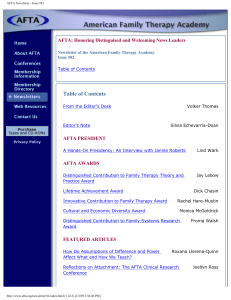Vietnamese agriculture and global integration
advertisement
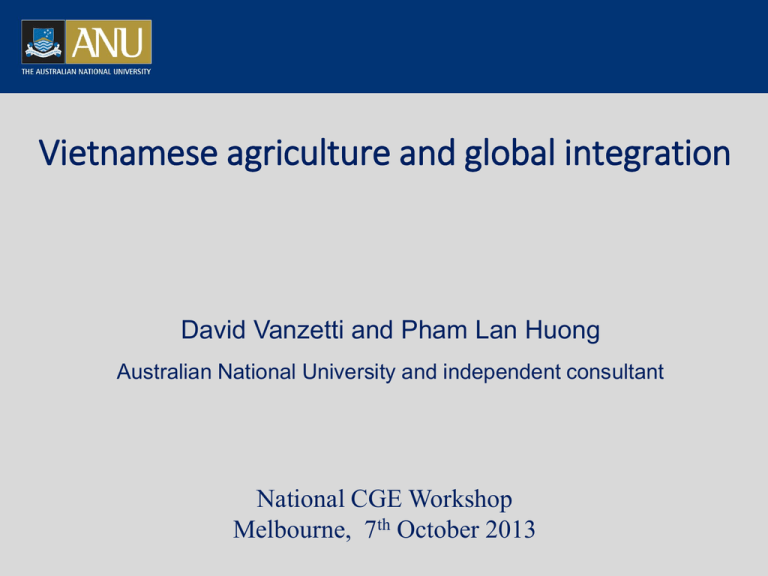
Vietnamese agriculture and global integration David Vanzetti and Pham Lan Huong Australian National University and independent consultant National CGE Workshop Melbourne, 7th October 2013 Integration and structural adjustment • Vietnam is signing up to bilateral, regional and multilateral trade agreements • Structural adjustment –the movement of factors of production (capital, labour and land) between sectors. • Declining sectors? • Unemployment of factors, particularly labour? 2 Objectives • Economic integration (four FTAs) • Assess macro and sectoral impacts • Identify need for structural adjustment 3 Global general equilibrium model • • • • • • GTAP Version 8, base 2007 Bilateral trade and tariffs (2010) Includes preferential tariffs (needed for FTAs) Whole economy Includes resource (land, labour, capital, natural resources) constraints • Limitation - each country: one region, one household 4 Scenarios • Four FTAs • AFTA • China • Korea • Japan • All simultaneously • Each FTA without exemptions 5 Methodology • Based on negotiated FTA schedules • Specify bilateral tariff cuts for 5113 products • Aggregate (trade weighted) to 24 sectors by 19 regions using TASTE • Specify baseline growth assumptions • Specify labour and capital market assumptions • Simulate • Report 6 Exemptions • Scheduled tariff cuts have exemptions for sensitive products • Few in number but cover large volume of trade • These differ by partner • Specify HS 6 level tariff cuts (5113 products) from bilateral applied tariff schedules as negotiated 7 Sectoral coverage Primary Processed Rice Sugar Vegetables fruit and nuts Beef Cereal grains nec Pork and poultry Cane sugar Dairy products Other crops Other processed agriculture Oilseeds Textiles Cattle Motor vehicles and other trans Other aninmal products Manufactures Raw milk Electronics Forestry Transport & communications Fishing Business services Petroleum and coal products Services and activities NES 8 Reported results • • • • • • Welfare (national income) Imports Exports Employment and wage rates Tariff revenue Sectoral effects (production and trade) 9 Baseline 90000 Deviation 80000 70000 60000 50000 Projected Simulated 40000 30000 20000 Historical Projection 10000 0 2007 2008 2009 2010 2011 2012 2013 2014 2015 2016 2017 Schematic representation. Not to scale. 10 Baseline in steps 90000 Deviation 80000 70000 60000 50000 Projected Simulated 40000 30000 20000 Historical Projection 10000 0 2007 2012 2017 11 Change in FTA tariffs on Vietnam’s exports 40 35 30 25 % 20 15 10 Base Final 5 0 Source. GTAP 2010. 12 Change in tariffs on Vietnam’s imports 30 25 20 % 15 10 5 Base Final 0 13 Results • Macro • • • • • Welfare Exports Imports Tariff revenue Real wages • Agricultural sector • Output • Exports • Imports 14 Vietnam welfare gains in 2017 relative to 2012 30000 25000 20000 $m 15000 10000 5000 ALL KOR JPN CHN AFTA BASE 0 Income growth important 15 Vietnam trade impacts in 2017 relative to base 20 18 16 14 12 % 10 Exports Imports 8 6 4 2 ALL KOR JPN CHN AFTA 0 Growth in imports exceed imports 16 Vietnam trade balance in 2017 relative to base ALL KOR JPN CHN -1000 AFTA 0 -2000 -3000 $m -4000 -5000 -6000 -7000 -8000 17 Welfare with and without exemptions in 2017 relative to base 7000 6000 5000 4000 $m Exempt No exempt 3000 2000 1000 ALL KOR JPN CHN AFTA 0 Japanese rice tariffs 18 Real wages in 2017 relative to base 16 14 12 10 % 8 Unskilled Skilled 6 4 2 ALL KOR JPN CHN AFTA 0 Fixed employment for skilled labour 19 Vietnam tariff revenue in 2017 relative to base 8000 7000 6000 5000 $m 4000 3000 2000 1000 ALL KOR JPN CHN AFTA BASE 0 20 Agricultural sector impacts • • • • • Output Exports Imports Use of land, labour and capital Factor prices 21 80 0 -20 Rice Vegetables fruit… Cereal grains nec Cane sugar Other crops Oilseeds Cattle Other animal… Raw milk Forestry Fishing Petroleum and coal… Sugar Beef Pork and poultry Dairy products Other processed… Textiles Motor vehicles and… Manufactures Electronics Transport &… Business services Services and… Change in output in 2017 relative to 2012 100 Base ALL Textiles Cassava 60 %40 20 22 Change in exports in 2017 relative to 2012 160 140 Cassava 120 100 80 % 60 40 Base ALL 20 Proc. Ag Pork&Poult Beef Sugar Animal products Switch to cassava from other crops Cattle Crops Oilseeds -60 Cereals -40 Veg -20 Rice 0 23 Change in imports in 2017 relative to 2012 120 Feed. Processed agriculture. 100 80 % 60 40 Base ALL 20 Proc. Ag Dairy Pork&Poult Beef Sugar Animal products Cattle Oilseeds Crops Cereals Veg 0 24 Use of factors in agriculture Change in 2017 relative to 2012 70 60 50 40 30 % 20 10 0 -10 -20 -30 Land Labour Capital 25 Factor prices in 2017 relative to 2012 100 80 60 40 BASE ALL FTA % 20 0 Land -20 Unskilled labour Skilled labour Capital Natural Res. -40 26 Summary of macro results • Income growth important. Changes implemented against background of expanding economy • Positive welfare effects (national income) from FTAs • Real wage increases • Tariff revenue reduced somewhat • Trade balance negative 27 Policy implications • • • • • • Income growth depends on capital (macro policy) Non-tariff barriers still exist, and may increase Structural adjustment manageable Need flexible land, labour and capital markets WTO virtually completed. No further tariff cuts Ignored here other FTAs, such as EU, Trans Pacific Partnership, Regional Comprehensive Economic Partnership 28 The End 29



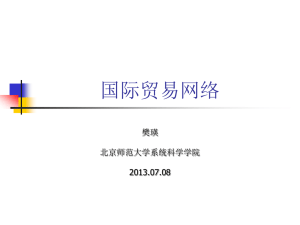
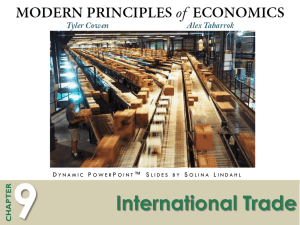

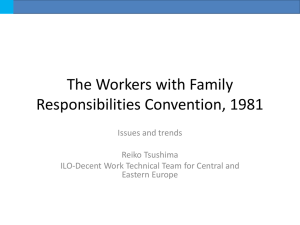

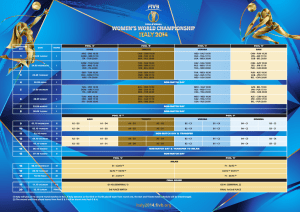
![Presentation [PDF:863KB]](http://s2.studylib.net/store/data/005548425_1-ead9d4105297a66953ee7241b3c01e6e-300x300.png)
